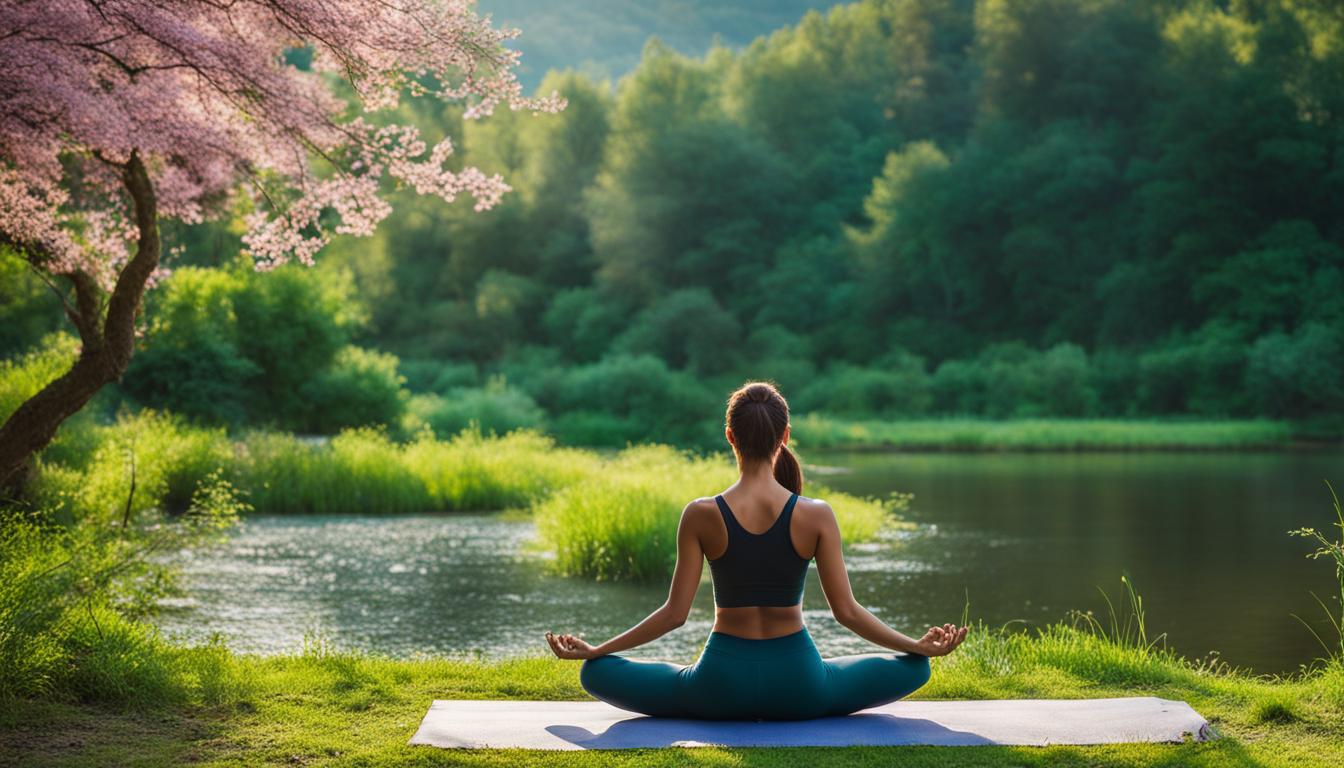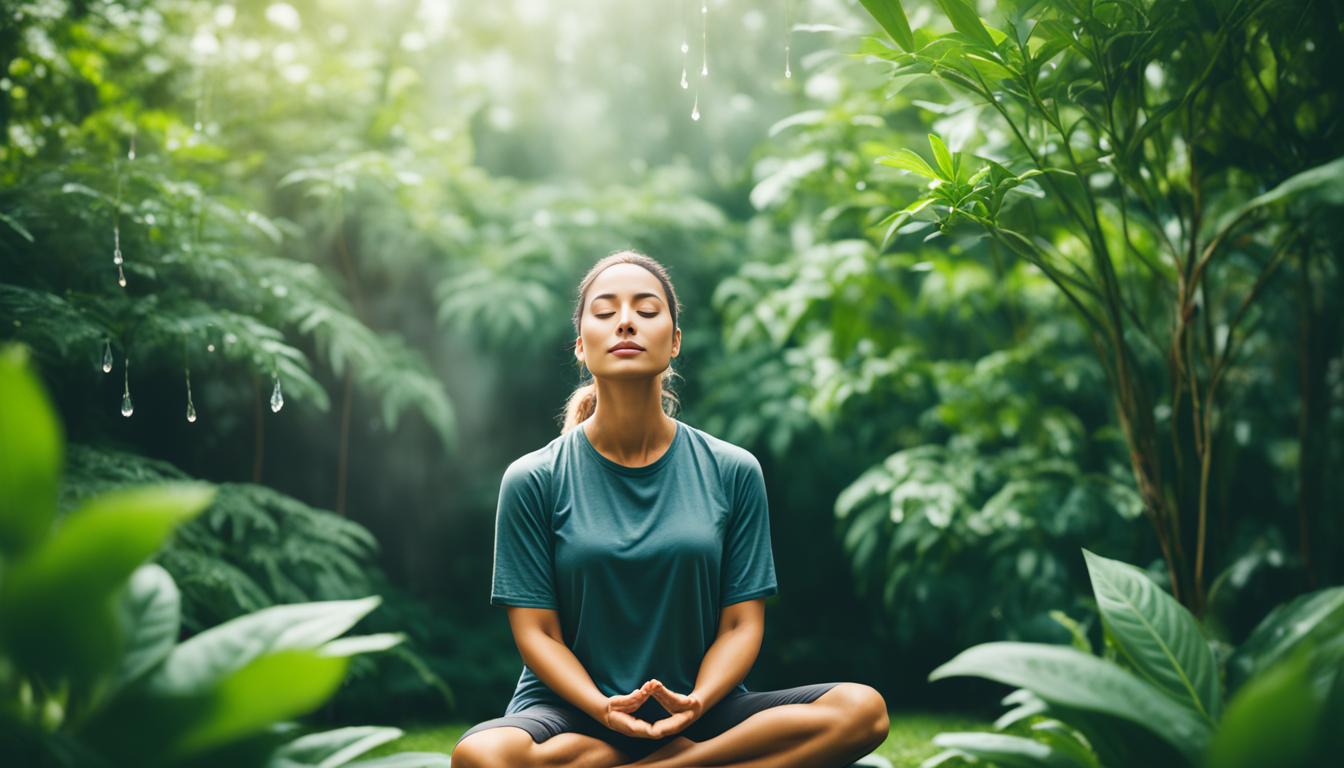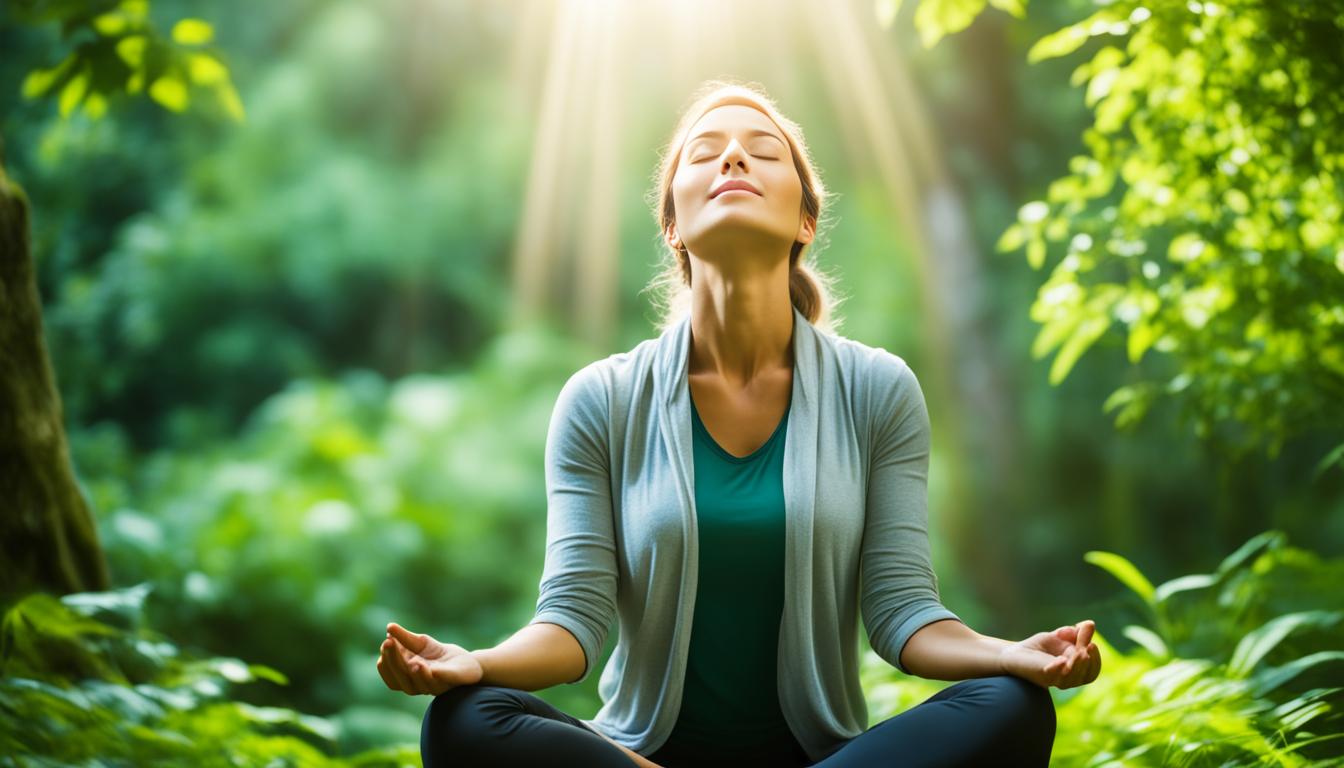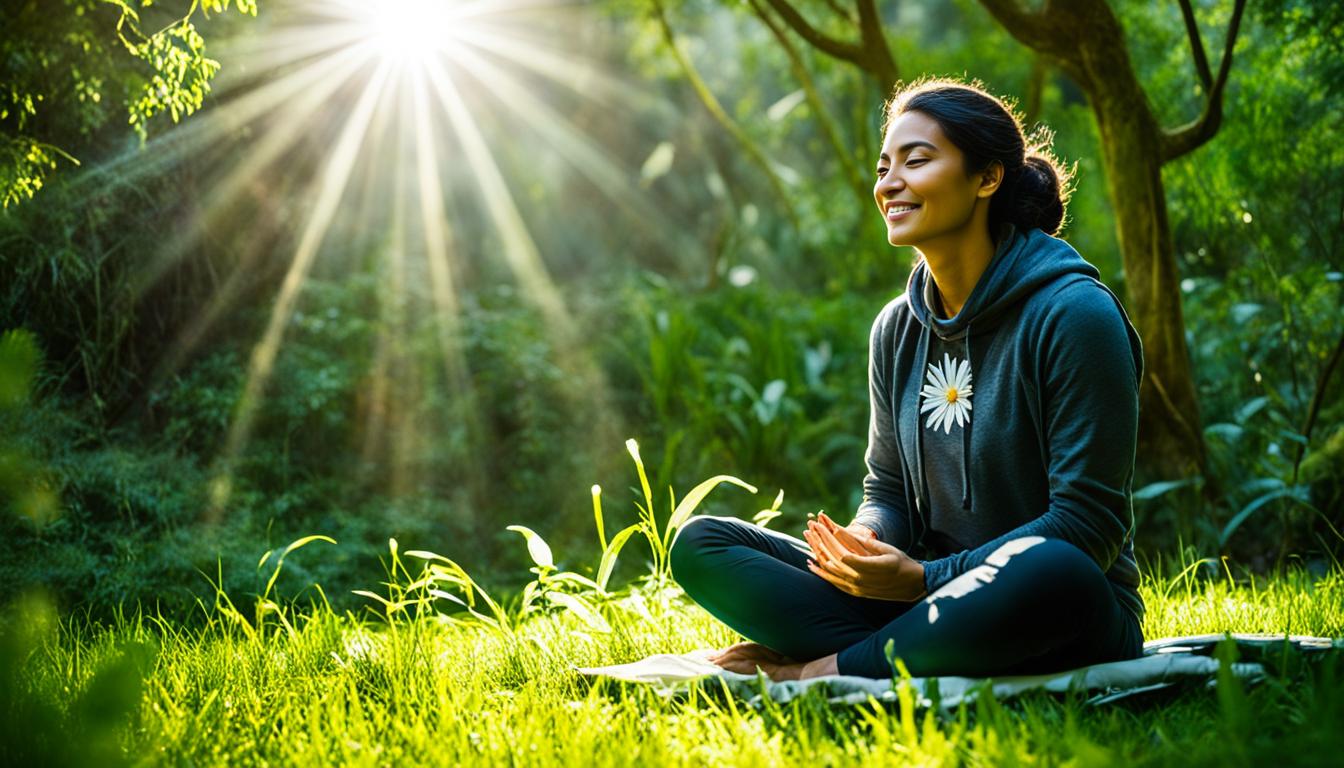Disclosure: This Post Contains Affiliate Links; We earn a commission on purchases.
If you’re looking for a natural and effective way to reduce stress, yoga may be the answer you’re looking for. Yoga is a mind-body practice that combines movement, breathing techniques, and meditation to promote relaxation and overall well-being. It has been widely recognized for its ability to reduce stress, anxiety, and depression, making it a valuable tool for managing the challenges of daily life.
Key Takeaways:
- Yoga is a holistic practice that incorporates movement, breathing, and meditation to reduce stress and promote relaxation.
- Regular yoga practice can help balance the nervous system and release positive hormones in the body, improving mental health and overall well-being.
- There are various types of yoga, each offering unique benefits for stress relief.
- Simple yoga poses such as the Corpse pose, Reclining Bound Angle pose, and Legs-Up-the-Wall pose can help relieve stress and tension.
- Mindful breathing and mindfulness play a crucial role in enhancing the stress-relieving benefits of yoga.
The Benefits of Yoga for Stress Relief
Yoga offers a wide range of benefits for stress relief and overall mental well-being. It goes beyond physical exercise and encompasses a lifestyle that includes its own philosophy and psychology. Through controlled breathing, meditation, and physical postures or asanas, yoga helps improve the mind-body connection and promotes relaxation. By balancing the sympathetic and parasympathetic nervous systems, yoga reduces anxiety, depression, and stress. It has been shown to have positive effects on mental and emotional well-being, ultimately enhancing the overall quality of life.
In addition to stress relief, yoga offers various other advantages for mental well-being. It allows individuals to cultivate a better understanding of their thoughts, emotions, and bodies, fostering self-awareness and self-acceptance. The practice of yoga encourages individuals to be present and mindful, creating a sense of inner calmness and balance. Moreover, the physical exercise involved in yoga helps release endorphins, the body’s natural feel-good hormones, which further contribute to positive mental well-being.
Reduced Stress and Anxiety
Yoga is a powerful tool for reducing stress and anxiety. Through the combination of physical movement, breathing techniques, and meditation, yoga triggers the body’s relaxation response, counteracting the effects of stress. By engaging in yoga regularly, individuals can learn to manage stress more effectively, build resilience, and experience a greater sense of calmness and tranquility in their daily lives.
Mood Enhancement and Depression Management
Practicing yoga has been shown to enhance mood and aid in depression management. The combination of deep breathing, stretching, and mindfulness practices in yoga contributes to increased levels of serotonin, a neurotransmitter associated with mood regulation. Regular yoga practice can help alleviate symptoms of depression and improve overall emotional well-being.
Improved Physical Fitness
While yoga is primarily known for its mental benefits, it also provides a comprehensive physical workout. The asanas or yoga postures challenge balance, flexibility, and strength, resulting in improved physical fitness. Engaging in a regular yoga practice can lead to increased muscle tone, improved posture, and enhanced overall physical performance.
Enhanced Mind-Body Connection
Yoga promotes the integration of mind and body by emphasizing the connection between breath, movement, and awareness. Through focusing on these elements, individuals are able to develop a deeper understanding and appreciation of their physical and mental well-being. This mind-body connection cultivated in yoga can help individuals better manage stress, cope with emotions, and improve overall self-awareness.
Stress Relief for the Mind and Body
The practice of yoga provides a holistic approach to stress relief, addressing both the physical and mental aspects of well-being. By incorporating yoga into their lives, individuals can experience reduced stress, improved mental clarity, enhanced physical fitness, and a greater sense of overall well-being.
Simple Yoga Poses for Stress Relief
When it comes to finding relaxation and relief from stress, incorporating simple yoga poses into your daily routine can work wonders. Not only do these poses help release tension in the body, but they also promote mental calmness and a sense of overall well-being. Whether you’re new to yoga or a seasoned practitioner, these restorative asanas are accessible to all and can provide a much-needed break from the demands of everyday life.
Let’s explore some of these stress-relieving yoga poses:
- The Grace Canaan Pose: This pose is perfect for relaxation and improving posture. By gently opening up the chest and lengthening the spine, it helps release tension in the upper body and promotes a sense of grace and ease.
- The Corpse Pose: Also known as Savasana, this pose is believed to energize the body while inducing a deep state of relaxation. By lying flat on your back with your arms and legs extended, you can experience a profound release of physical and mental tension.
- The Reclining Bound Angle Pose: This restorative pose is great for releasing tension in the pelvic area, stretching the inner thighs, and opening up the chest for better breathing. By supporting your knees with props, such as blankets or cushions, you can find a comfortable position that allows for deep relaxation and restoration.
Other stress-relieving yoga poses that can help promote relaxation and mental calmness include the Legs-Up-the-Wall pose, Forward Fold pose, and Seated Forward Bend pose. These poses reverse the movement of the body, releasing tension and allowing for a greater sense of ease and equilibrium.
By incorporating these hatha yoga poses into your routine, you can experience the benefits of stress relief and mental rejuvenation. Remember to listen to your body, go at your own pace, and embrace the restorative power of yoga.
The Importance of Mindful Breathing in Yoga for Stress Relief
Mindful breathing plays a crucial role in achieving stress relief through yoga. It serves as a grounding practice that allows individuals to slow down, collect themselves, and be fully present in the moment. By placing focused attention on the breath, yoga practitioners can activate the body’s relaxation response and effectively reduce stress levels.
When practicing mindful breathing, the emphasis is on deep and intentional breaths. Inhaling deeply and exhaling slowly sends a signal to the body to relax. This controlled breathing technique calms the nervous system, slows down the heart rate, and lowers blood pressure. As a result, the mind also experiences a sense of calmness and clarity.
Integrating breathwork exercises into yoga sessions brings tremendous benefits for stress management and overall well-being. It allows individuals to tune into their bodies, release tension, and promote mental and physical relaxation. Mindful breathing serves as a powerful tool for relieving anxiety, as it aids in shifting focus away from stressful thoughts and redirecting attention to the present moment.
One popular breathwork technique used in yoga is deep belly breathing. This method involves breathing deeply into the belly, expanding the diaphragm, and consciously exhaling fully. Deep belly breaths activate the body’s relaxation response, counteracting the fight-or-flight response often associated with stress. The consistent practice of deep breathing helps regulate emotions and promotes a greater sense of inner peace.
Another effective breathing technique commonly used in yoga is alternate nostril breathing. This practice involves inhaling through one nostril while closing the other with the thumb and then exhaling through the opposite nostril. Alternate nostril breathing balances the right and left hemispheres of the brain and harmonizes energy flow throughout the body. It promotes mental clarity, reduces anxiety, and fosters a state of relaxation.
By incorporating mindful breathing into a regular yoga practice, individuals can develop stress management skills that positively impact their well-being. Mindful breathing provides a pathway to deeper meditation, further enhancing the stress-relieving benefits of yoga. It offers an opportunity for self-reflection, introspection, and the cultivation of mindfulness.
So the next time you unroll your yoga mat, remember the profound impact that mindful breathing can have on your stress relief journey. Embrace the power of deep, intentional breaths and allow yourself to fully experience the calming and purifying effects of mindful breathing in your yoga practice.
The Role of Mindfulness in Yoga for Stress Relief
Mindfulness plays a crucial role in the practice of yoga for stress relief. It involves cultivating a deep sense of awareness and being fully present in the current moment. By focusing on self-care and self-respect, mindfulness enables individuals to effectively navigate the challenges of everyday life.
When faced with stress challenges, practicing mindfulness in yoga allows us to respond with less reactivity and more acceptance. By neutralizing negative emotions and thoughts, mindfulness helps to create a calm and balanced state of mind.
“Mindfulness is the aware, balanced acceptance of the present experience. It isn’t more complicated than that.” – Sylvia Boorstein
The integration of mindfulness into yoga enhances its overall stress-relieving benefits. By bringing awareness to our thoughts, feelings, and bodily sensations, mindfulness allows us to observe them without judgment, thereby reducing their control over us.
By fostering a greater sense of acceptance and non-resistance, mindfulness in yoga helps us neutralize negative emotions and thoughts, creating space for greater peace and well-being.
Benefits of Mindfulness in Yoga
Practicing mindfulness in yoga offers numerous benefits for stress relief and mental well-being:
- Increased self-awareness and self-acceptance
- Improved emotional regulation
- Enhanced ability to handle stress
- Reduced reactivity to challenging situations
- Heightened focus and concentration
By incorporating mindfulness into their yoga practice, individuals can experience a deeper sense of calmness, resilience, and overall satisfaction in life.
Bringing Mindfulness to Your Yoga Practice
If you’re new to mindfulness, here are a few tips for incorporating it into your yoga practice:
- Start by setting an intention to stay present throughout your practice.
- Focus on your breath and bring attention to the sensations in your body as you move through each pose.
- When distracting thoughts arise, gently acknowledge them and guide your attention back to the present moment.
- Practice non-judgment by observing your thoughts and sensations without attaching any labels or evaluations to them.
- Extend mindfulness beyond your mat and apply it to your daily life. Notice the small moments of mindfulness in everyday activities like walking, eating, or having a conversation.

Mindfulness is a powerful tool that can deepen the benefits of yoga for stress relief. By incorporating mindfulness practices into your yoga routine, you can cultivate a greater sense of awareness, acceptance, and peace, helping you to better manage stress and improve your overall well-being.
Getting Started with Yoga for Stress Relief
Starting a yoga practice for stress relief is a simple and effective way to manage stress and promote physical and mental well-being. With just a few basic yoga equipment and a commitment to self-care, you can embark on a journey of relaxation and inner peace.
Yoga Equipment for Stress Relief
To get started, all you need is a yoga mat or a towel to provide a comfortable surface for your practice. You can also consider using additional props such as blocks, blankets, or cushions to support your body and enhance your comfort during the poses.
Choosing the Right Space
Finding a quiet and uninterrupted space is essential for practicing yoga. It allows you to create a serene environment where you can fully immerse yourself in the practice and focus on relieving stress. If possible, consider moving your yoga practice outdoors to enjoy the added benefits of nature and fresh air.
Mindful Yoga for Stress Relief
When you’re ready to begin your yoga practice, start with gentle stretching exercises to warm up your body. Pay attention to each movement, connecting your breath with the flow of your body, and embrace mindful awareness throughout your practice.
Remember, yoga is more than just physical poses. It’s a practice that combines movement, breathwork, and mindfulness to cultivate inner peace and promote overall well-being.
Listening to Your Body
Throughout your yoga practice, it’s vital to listen to your body and honor its needs. If a pose feels uncomfortable or causes pain, feel free to modify or skip it. Self-care and self-commitment are key elements of a successful yoga practice for stress relief.
By incorporating yoga into your daily routine, you can effectively manage stress, improve your physical and mental well-being, and experience the transformative power of this ancient practice.
Yoga Poses for Stress Relief to Try
Yoga offers a wide range of poses that are specifically designed to reduce stress and promote relaxation both physically and mentally. Incorporating these poses into your yoga practice can provide significant benefits for stress management and overall well-being. Here are some recommended yoga poses for stress relief:
- Sun Salutation Pose: This pose warms and aligns the body, promoting a sense of calmness and rejuvenation. It involves a sequence of movements that invigorate the entire body and help release tension.
- Sitting Pose: Maintaining a comfortable and balanced posture is important for stress relief. The Sitting Pose helps stabilize the body and allows for deep breathing, promoting relaxation and mental clarity.
- Child’s Pose: This soothing position helps relax the mind and soothes the adrenals. It involves sitting on the heels and gently folding the torso forward, providing a sense of comfort and release.
- Eagle Pose: The Eagle Pose offers physical and mental benefits for reducing stress and anxiety. It helps improve focus, balance, and concentration, while also stretching and strengthening various muscles in the body.
- Bridge Pose: The Bridge Pose helps relieve tension in the back and hips, promoting relaxation and a sense of openness. It also stimulates the thyroid and calms the nervous system.
- Extended Triangle Pose: This pose stretches and lengthens the muscles, promoting physical and mental well-being. It helps relieve stress and anxiety while improving overall flexibility and balance.
These yoga poses can be practiced individually as needed or as part of a regular yoga routine. Experiment with different poses to find the ones that work best for you and provide the most stress relief. Remember to listen to your body, breathe deeply, and maintain a sense of mindfulness throughout your practice.

Testimonial:
“Incorporating these yoga poses into my daily routine has made a significant difference in my stress levels. I feel more relaxed, grounded, and better able to manage the challenges of everyday life. Yoga has truly become my go-to practice for finding inner peace and tranquility.” – Amanda
Incorporating Yoga into Your Daily Routine for Stress Relief
In today’s fast-paced world, stress relief has become more important than ever. One effective way to manage stress is by incorporating yoga into your daily routine. You don’t need to spend hours on your mat; even short mini yoga breaks throughout the day can make a significant difference in reducing the accumulation of stress in your mind and body.
By taking just a few minutes to practice one pose or a series of poses, you can experience immediate relief and promote both mental and physical well-being. Consistency is key to reaping the stress-relieving benefits of yoga, so finding a routine that works for you is essential.
Whether you prefer to start your day with a morning yoga session or wind down with an evening practice, adding yoga to your daily routine can support stress management and overall well-being. These mini yoga breaks can serve as mindful moments of self-care in the midst of a busy day, helping you find balance and reconnect with yourself.
To get started with incorporating yoga into your daily routine, consider the following tips:
- Set aside dedicated time: carve out specific time slots in your schedule for your daily yoga practice. Treat it as a non-negotiable commitment to your mental and physical well-being.
- Find a quiet space: create a tranquil environment where you can practice without interruptions. This can be a spare room, a peaceful corner of your home, or even a serene outdoor spot.
- Start small: if you’re new to yoga, begin with gentle stretching exercises and gradually incorporate more challenging poses. This allows your body to adjust and build strength over time.
- Focus on mindful breathing: pay attention to your breath during your yoga practice. Deep, intentional breathing can help calm the nervous system and further alleviate stress.
- Listen to your body: honor your body’s limitations and avoid pushing yourself too hard. Always respect your body’s signals and adjust your practice accordingly.
Remember, it’s not about perfection, but about the journey of self-discovery and self-care.
By incorporating yoga into your daily routine, you create space for yourself amidst the chaos of everyday life. These mini yoga breaks offer a respite from the demands of the day and provide an opportunity to reconnect with your inner peace and resilience.
Now, take a moment to practice a simple yoga pose right where you are. Sit up straight, close your eyes, and take a deep breath in… and exhale, letting go of any tension or stress. Repeat this a few more times, noticing how your body feels with each breath.
Allow yourself to fully embrace the calming effects of yoga, and make it a regular part of your daily routine. Your mind and body will thank you for it.
Conclusion
Yoga offers a holistic approach to stress relief, combining movement, breathing techniques, and mindfulness to promote relaxation and well-being. By incorporating yoga into your daily routine, you can experience significant benefits in reducing stress, anxiety, and depression. Practicing yoga poses allows you to focus on mindful breathing and cultivate mindfulness, enabling you to develop valuable tools for managing stress and improving overall mental health.
It is important to listen to your body, go at your own pace, and make yoga a regular part of your self-care routine. By embracing a regular yoga practice, you can achieve a serene mind and body, promoting a sense of calmness and balance in your life. Remember that consistency is key, so continue to make yoga a priority in order to reap the full rewards.
Incorporating yoga into your daily routine is a rewarding journey that can lead to a happier and more peaceful life. The mindful movements and deep breathing techniques of yoga help calm the mind and release tension from the body. By dedicating time each day to practice yoga, you are investing in your own well-being and nurturing a positive relationship with yourself.
Source Links
- https://www.realsimple.com/yoga-for-stress-relief-7559654
- https://www.onepeloton.com/blog/yoga-for-stress-relief/
- https://moveon89.com/top-9-yoga-poses-for-stress-relief-pose-guide/
Ryan Conlon is a passionate advocate for mindfulness and meditation, dedicated to helping others discover the transformative power of these practices in their lives. As the founder of Daily Meditation, Ryan’s mission is to provide a sanctuary for individuals seeking peace, clarity, and well-being amidst the chaos of modern life. With a background in psychology and years of personal experience with meditation, Ryan brings a wealth of knowledge and insight to his work. Through Daily Meditation, he shares practical guidance, inspirational content, and expert resources to support others on their journey toward greater mindfulness, resilience, and inner peace.
Subscribe to Our Newsletter


















